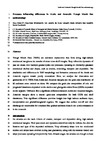Processes influencing differences in Arctic and Antarctic Trough Mouth Fan sedimentology
Date
2018-01-01Author
Metadata
Show full item recordAbstract
Trough Mouth Fans (TMFs) are sediment depocentres that form along high-latitude continental margins at the mouths of some cross-shelf troughs. They reflect the dynamics of past ice sheets over multiple glacial cycles and processes operating on (formerly) glaciated continental shelves and slopes, such as erosion, reworking, transport and deposition. The similarities and differences in TMF morphology and formation processes of the Arctic and Antarctic regions remain poorly constrained. Here, we analyse the dimensions and geometries of 15 TMFs from Arctic and Antarctic margins and the grain-size distribution of 82 sediment cores centred on them. We compare the grain-size composition of sub- and proglacial diamictons deposited on the shelves and glacigenic-debris flows (GDFs) deposited on the adjacent TMFs and find a significant difference between Arctic and Antarctic margins. Antarctic margins show a coarser grain-size composition for both GDFs and shelf diamictons. This significant difference provides insight into high-latitude sediment input, transportation and glacial/interglacial regimes. We suggest that surface run-off and river discharge are responsible for enhanced fine-grained sediment input in the Arctic compared to in the Antarctic.
Collections
Publisher
Editor
Volume
Pagination
Parent title
Publisher URL
Recommended, similar items
The following license files are associated with this item:


